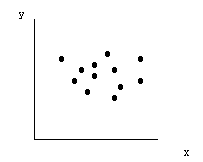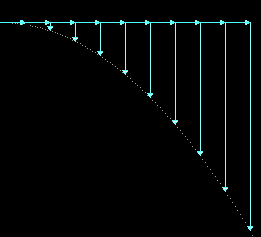K-4 PROJECTILE MOTION.
Purpose:
To study the geometry of the ballistic trajectory of a steel ball shot from a spring gun. In particular:
- Find the firing velocity from the range and angle of fire.
- Study the variation of range with firing angle.
Background:
|
The displacement of a projectile fired with initial velocity vo is given by:
| [1] |
s = vo t + (1/2) g t2
where t is the elapsed time and g is the constant acceleration due to gravity. From this we may derive the formula for the horizontal range, R, of a projectile fired upward at angle θ from level ground and landing on the same level:
| [2] |
R = (vo2/g) sin (2θ)
The range for horizontal firing at an elevation of H above the ground is:
| [3] |
R = vo(2H/g)1/2
The general formula that includes firing height and firing angle is:
| [4] |
R = (vo2/2g)(sin(2θ) {1 + [1 + (2gH/vo2sin2θ)]1/2}
Method:
A simple spring gun may be used to propel a steel ball horizontally from a table top. The ball initially rests in a depression in front of a spring-powered plunger, and the plunger may be drawn back to either of two positions. The position of impact of the ball with the floor may be conveniently marked by laying down a sheet of carbon paper (carbon side up) with a sheet of white paper taped down on top of it so it cannot move. when the steel ball strikes the paper it will leave a clear, black mark at the point of impact. Put a sheet of cardboard under all of this, to prevent the ball from denting or chipping the floor.
(1) The "range of a projectile" is the horizontal distance from the firing point to the point of impact. Determine how to set the ball and plunger to obtain the maximum range, and clearly state in your report how this was done.
(2) Place the recording paper at the point of impact, and fire the ball 20 times onto the same paper. Lay a one or two meter stick down from a point just below the firing point and extending along the floor in the direction of the line of fire. Draw a straight line along the stick on the paper, and mark a reference point on the paper so the distances of spots from the firing point may later be determined. Remove the paper from the floor and save it for analysis and inclusion in your report.
(3) Also measure the height of the firing point above the floor and estimate the uncertainty in this measurement. Before leaving this experiment, examine it for other sources of uncertainty.
Firing at an angle upward: Here the purpose is to investigate the variation of range with angle. The easiest situation to analyze is the case where the projectile release point and the landing point are on the same horizontal plane. Of course, this will require you to relocate the carbon paper with respect to the gun each time the angle of fire is changed. For each angle, fire at least five times, depending on the time you have.
Analysis:
(1) The range of scatter of the spots on the paper may easily be determined by drawing a boundary around the spots. We seek some "average" of these scattered spots, some "central" value from which to determine an average value of the range, R. It is possible that the best average position will not be at the center of the range, if the main clustering is off-center. There may also be "spurious" points far removed from the main cluster.
 |
| Fig. 2. Scatter of data points. |
|---|
(2) The initial velocity of the steel ball may be determined by the formula:
| [5] |
vo = R √(g/2H)
where R is the range, H is the height of the firing point, and g is the "acceleration due to gravity", 9.807 meters/sec2. Calculate vo and its uncertainty, using the methods of chapter 3 of reference 1.
(3) Plot the range as a function of firing angle.
(4) Plot the range as a function of sin(2θ).
Questions:
1. Derive equation 3. Show that equations 1 and 2 are special cases.
2. The firing mechanism of the spring gun may have variation in the speed of the ball, and in the angle at which the ball is relased. Both of these cause variation in the range. Show how much variation is caused in the range by a vertical error of angle of ± 1° from horizontal in level firing.
3. You plotted the range as a function of sin(2θ). If equation 2 were strictly valid, this should be a straight line passing through the origin. It probably isn't. Why?
© 1999, 2004, by Donald E. Simanek.
